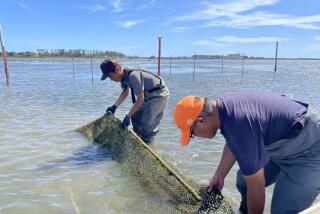Fish May Cost $12 a Pound in Markets Soon : U.S. Salmon Prices Leap With Japanese Yen
- Share via
SEATTLE — The Japanese yen is strong and the dollar is weak, and salmon fanciers in the Northwest are paying for this lesson in international economics at the fish counter.
“It’s outrageous,” said John Russell of Pure Food Fish in Seattle’s Pike Place Market where fresh chinook, or king, salmon steaks and filets that sold a year ago for $4.95 and $5.95 a pound now run $7.95 to $8.95.
“I think you can safely say that Japan is setting the market for the species that are valued over there, especially the reds (or sockeye) and chum (sometimes called keta or brites),” said Lee Alvorsen of Northwest Resources Consultants.
The bad news for consumers has been good news for Northwest fishermen, who have been netting many more dollars for the same amount of work.
With rising demand but no increase in the harvest, the Japanese have begun buying other species as well, raising the possibility that salmon could be priced off many tables in the Northwest. In other parts of the country where salmon are shipped, price increases could be even higher, Alvorsen said.
“They’re basically buying them for 50-cent dollars,” said Alec Brindle, president of Ward Cove Packing Co.
Kings, frequently 20 pounds or larger, and the darker sockeye, usually around six pounds, are prized for their oily, succulent flesh.
Coho, or silver, range from small to intermediate in size and are less oily, while chum, intermediate in size, are drier still. Pinks or humpys, the smallest, run around four pounds and have the driest and lightest colored flesh. Pinks and sockeye are the most numerous.
Some restaurants renowned for their fish dishes have dropped certain kinds of salmon.
It’s a Bad Value
At Ray’s Boathouse, executive chef Wayne Ludvigsen said he quit buying sockeye rather than boost the menu price to $18 or $19. He had charged $13 or $14 the past few years.
“I don’t know of anybody else who has it on the menu,” Ludvigsen said.
“It’s become a bad value,” he said. “It’s almost that the market was so strong . . . that quality was not the thing, just getting the fish was the thing.”
“We’re reaching price levels that we’ve never seen before, so nobody really knows what the ceiling is,” said Bruce Gore, Ludvigsen’s supplier of king salmon that runs $16.95 a plate.
Gore, who fishes, cleans and flash-freezes fish at sea from 10 other boats and sells about 200,000 to 250,000 pounds a year to retailers and restaurants, predicted that top-quality frozen salmon would reach $10 to $12 a pound at the counter this winter.
“A growing percentage of people are just going to buy chicken instead,” he said.
“Salmon has probably escalated as fast or faster than any seafood,” said Tom Dehn, special seafood merchandiser at Pacific Fish Co.
Japanese buying was the main reason for the record $705 million paid to commercial fishermen for a so-so Alaska salmon catch of 99.5 million fish this year.
Salmon hauled aboard boats from Washington state brought fishing crews about $240 million and processors $525 million for 67,000 metric tons of fish this year, compared to $135 million and $297 million, respectively, for 66,000 tons in the previous season, Alvorsen said. He noted that salmon prices pretty much rose with the rise of the yen, coupled with a falloff from record catches of the mid-1980s and declining frozen and canned inventories.
Chuck Meachum, Alaska Department of Fish and Game research supervisor for the Bristol Bay region, said the transition from canning chiefly for European countries to freezing overwhelmingly for the Japanese had resulted in “a very, very strong correlation . . . between the price U.S. fishermen are paid and the U.S.-Japan exchange rate.”
More to Read
Sign up for Essential California
The most important California stories and recommendations in your inbox every morning.
You may occasionally receive promotional content from the Los Angeles Times.













